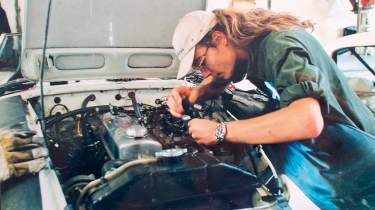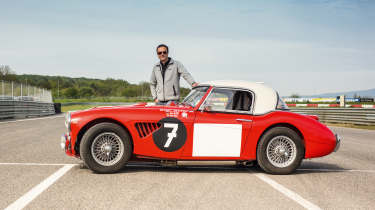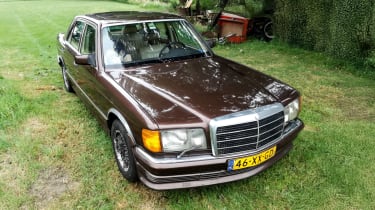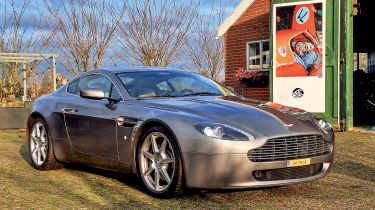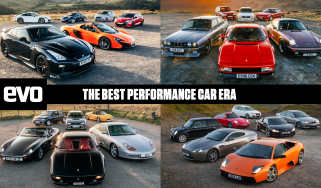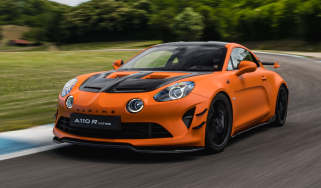Inside the life (and garage) of the engineer driving Vredestein’s success
When Tjeerd Buijinck isn’t developing and signing off new tyres, he tends to his eclectic car collection, which includes a number of British classics
From very, very young, I was interested in everything mechanical, but my dad was a forester so he didn’t really nurture that part of me,’ says Tjeerd Buijinck, looking back on his early life in the Netherlands. ‘We moved house several times, and when I was ten my new school was across the street from a company doing race and rally preparation for historic vehicles. Every time after school I was glued to the window of that place, for I think a month, and then finally this guy opens the door and he says: “Hey, I noticed you’ve been standing in front of my shop the last four weeks, would you like to come in?” I can still vividly remember that day; I still get goosebumps because that really kicked it all off. He had a very nice company preparing historic race and rally cars, mainly Austin-Healeys but Lotuses and Astons too, and basically he became my second dad. So that was the start of my career actually.’
The business was LB Racing, owned and run by Mark Schmidt. ‘I remember that I wasn’t even tall enough to look on the workbench; I had to get a jerry can or set of wheels to stand on to see what he was actually doing. He let me start by brooming the floor, sorting the tools, you know, the basic things that you can let a ten-year-old do. From that it evolved into repairing rusty chassis. I took apart at least 150 Healeys, which at that time were still coming from the US as parts cars and restoration projects. I spent literally every spare hour there.
> Meet the man who turned a Lotus Exige into a 270mph hypercar
‘I knew that I wanted to be an engineer, to understand what was actually going on, and so I went to a technical university for engineers. The school was HTS Autotechniek Apeldoorn, now called HAN University in Arnhem. It’s quite a famous school, at least in Germany and the Netherlands. So there I really got into mathematics, all the theories about roadholding, about springs, suspensions, engines, gearboxes, the whole thing.’
Perhaps inevitably, Tjeerd’s first car was British. ‘It was a Mini. It was like 15 shades of green because it was repaired and mended endlessly. To start with it was very standard but, of course, immediately I started to go into the parts bins at LB Racing and I found a Weber carburettor, and then I found 1275 engine… In the end that car morphed into an Innocenti Cooper, meaning that I used the body of the first Mini to build the second, something that’s common practice I think also in England.
‘It had adjustable suspension, a roll-cage… the full Monty. It was really quick actually, weighing just 490 kilograms, and on the rolling road it had 90-95 horsepower at the wheels. Fun car! But my girlfriend wasn’t too fond of it because, to make a Weber carb fit, I had to cut the firewall. I made some aluminium plating but on every downshift it would pop in the carburettor and a nice orange flame came shooting to your feet.
‘Then I had a Triumph Spitfire, then a Rover P6, a V8, then I think I had my first Mercedes. I was absolutely not a Mercedes fan but after breaking down in my British cars, basically every day, a Mercedes was quite a relief because it’s so beautifully engineered. It was a 1980 S-class and it was so nicely put together. Also road tax free, which is a big thing in the Netherlands. That was one of the reasons why I bought it actually. It’s still a thing; I have quite a lot of cars right now and most of them are tax-free, which is of course a big plus because all you have to do is pay like £50 a year in insurance.
‘So my friend was preparing these historic rally cars and he was also competing on a European level. We, as a team including Mark’s brother, even got the European championship with his Healey, with me as the engineer, chief mechanic or whatever you want to call it. We did rallies in Scotland with exploding engines, Spa-Francorchamps with exploding rear axles that I had to fix. That’s what I did between age ten and 25, so I definitely knew that an office job was never going to be for me.’
Tjeerd didn’t plan on being a test driver. It was more by chance that he found out that he was handy behind the wheel. ‘There was some driver training for the Dutch Healey Club members and I was offered a drive in the competition by a generous owner who then slightly regretted it when I was third fastest. That was funny!
‘After graduating, I started working for an engineering firm in the Netherlands that did a lot of work for the German car industry. I worked in simulation, I worked in the testing department, I worked on four-poster rigs for vehicle movement, I worked in the crash laboratory, so it was a nice learning school. Then Vredestein came with a job opening for a test engineer and I said, “Well, let’s go for it.” It was love at first sight and it’s been almost 20 years now.’
Now 46, Tjeerd is manager, test engineering at Apollo Tyres Ltd – the company that acquired Vredestein in 2009 – and has the responsibility for signing off new tyres. ‘In all honestly, I’m not the only one signing off tyres. We are five or six people. We’re in the testing department, so we have different projects for both OE and the replacement market, and the various OEMs have one designated driver. I cannot do everything myself but I try to drive every product we bring in the market. I have to be able to ask the critical questions and that’s only possible when you get behind the wheel yourself.’
Since Apollo Tyres acquired Vredestein, the latter has grown enormously and is now a truly global brand. ‘Before that, Vredestein was a very nice company but it was quite small,’ says Tjeerd. ‘When I started we had a testing department with five people and we were going to the track every third week. Now that we have 40-plus people we are testing in parallel at three, sometimes even five, six locations at the same time every week. So it’s around-the-clock testing around the globe, and our portfolio of products has grown tremendously. My job is completely different than what it was 20 years ago.
‘My time in the workshop working on cars, that is over – at work at least. What I think is very nice about my job is that it’s 30-30-30. So it’s 30 per cent driving, 30 per cent inevitable office stuff and 30 per cent travelling and arranging stuff. It’s a nice mix and I think it’s also what keeps me going. It means that I’m travelling quite a lot, which is not always nice of course if you have a family, but the mix makes me really enthusiastic. I couldn’t do it without the driving part.’
Vredestein is a growing brand and has ambitions to compete with the established premium brands like Michelin, Pirelli and Continental. So how do you elevate your brand to start to compete with them? ‘The performance needs to be there,’ says Tjeerd. ‘If the tyre’s not performing in an independent test, then there’s not a lot to talk about. Brand image is very much connected to the performance of the tyres, but the performance absolutely needs to be there, that’s the key, and that, of course, means a lot of R&D. The R&D department has grown significantly compared to 10 to 15 years ago. If Apollo Tyres hadn’t invested so much in R&D we would not have achieved the level we are achieving right now.’
What’s the biggest change he’s seen in the tyre industry? ‘The introduction of silica [silicon dioxide, which helps wet performance] was a big step, but I think the big change that is happening right now is the growth of the all-season tyre market. We were a little bit laughed at in the beginning when we launched our all-season tyre 30 years ago but you’ll see now that more and more people are switching. Around 10 to 15 years ago all-season tyres were good but they were like a real compromise, and what you see right now is that in all conditions they are actually so good. Hardly a compromise anymore.’
Does he hanker after doing anything else, something other than tyres? ‘For me, the mix right now, it’s perfect. Vredestein has grown so much that not a day is the same. So in all honesty, I’m like a fish in the water. When I go to Finland for winter testing and I’m doing night shifts, I’m meeting guys that I’ve known for decades. I’ve been doing it for 20 years now. If I add up all the weeks, it’s almost one and a half years there. And thankfully there’s a new tyre launch event every two years where I’m involved and that also keeps me young and alive and fresh, talking to different people from different departments. So I’m happy.’
Tjeerd still tinkers with cars at home, in a huge garage that many enthusiasts would envy. ‘I spent plenty of time working on my cars on the street and in cramped places,’ he explains, ‘so I decided if I ever buy a house it’s got to have a big garage. So we came to see this place 17 years ago. My wife and me were standing back to back – I was looking to the cow shed saying, “Yes, this is it!” and my wife was looking at the farmhouse saying, “Yes, this is it!”.’
Of course, with Tjeerd being an enthusiast, the available space inevitably gets filled. Bits of his Innocenti Cooper live on in the Pimlico, a Mini-based kit car, including the engine, subframes and instruments. In the ‘Americana corner’ there’s a Harley, an F150 and a ’62 Thunderbird. ‘The T-bird is beautiful. The design is crazy. Absolutely fantastic. So we go for milkshakes when the sun is shining. The F150 pickup is rare because usually you have a large cabin and small bed or large bed and a small cabin but I have the big cabin and the big bed. It’s 6m 20cm long with a 4m wheelbase. Great for picking stuff up but it’s so big and won’t even fit in the McDonald’s drive-through.’
In another shed there’s a 1952 Bentley Mk6 Special to which he’s fitted a Rolls-Royce B80 straight-eight, with a plan to turn it into a pre-war racer ‘…or something like that. I’m not sure.’ The latest acquisition is a 2005 Aston Martin V8 Vantage. ‘I bought a Mercedes SL500, sold that really, really well and bought a Porsche 911, a 997.1 C2 manual. It was brilliant but I like to tinker with my cars and in five years nothing happened, so I sold it recently and bought myself the Aston, which brought back fond memories of the British cars; I’ve now spent six days working on it and I drove it eight, so the balance needs to change.’
Of course, there’s a Healey 3000 in the collection, a 1959 FIA racer, swapped for a TR7 V8 ‘Tony Pond’ rally replica he’d built from works parts, complete with a 5-litre V8 on quad 45 DCOEs. ‘I still love Healeys. It’s still a very, very special car to me. It’s a beast – you’ve got to tame it. It’s not like modern sports cars with ESP and ABS. These old cars tend to get you more involved. You’re more engaged. And if you mess it up, it’s your fault.’
He has perhaps only one regret. ‘I can remember, as a ten- or eleven-year-old, when I looked at a Healey it was just a beautiful form and a beautiful colour. When I look at a Healey now I see a parts list, a bill of materials!’
This story was first featured in evo issue 328.


